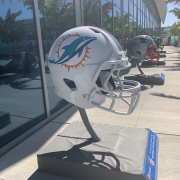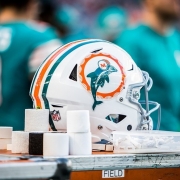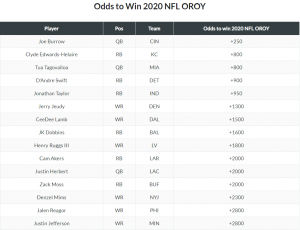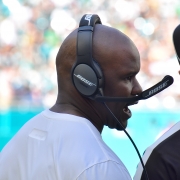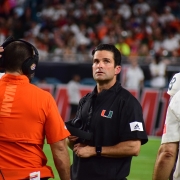The Most American Sport on the Brink Because of Modern Americanism
The first college football game I ever attended was some time in the mid-80s. My dad, a university professor, taught at Texas A&M University and the local Dairy Queen would always give out cheap tickets when the Aggies played Rice. So we went.
And I was hooked. College football is something I’ve always known and loved. That only grew when I moved to Miami, and eventually went to the University of Miami. It serves as a bond in my personal life. An excuse to see friends and family, to meet in person when we otherwise wouldn’t have the time, unite for common cause, to be irrationally depressed when Dan Enos calls a tight end reverse, to over-analyze things that we have no control over.
One of the great things about it is that it is the most American sport, more so than even baseball. We view college football how the rest of the world views soccer. Regional identity with a school/club, “legends” that are beloved in certain circles, long forgotten the rest of the world over, bands, songs…identity. Even if you never went to college, you can identify with a college and feel part of something. College football transcends cities and rural communities alike. When people ask me why soccer never got into the American ethos like it did the rest of the world, the answer is simple…that space is occupied by college football.
I never once envisioned a time when we would seriously have to consider how important it is, in the greater context of a society, because it all of a sudden feels so secondary. How important is this “game”?
More Than A Game
But that’s the thing…it’s not just a game. Sports is powerful because it is a reflection of society, the best and worst of it. It’s humanity laid bare, often subject to human error, including non-sensical pass interference flags after the national championship game is over. But the community-binding, the relationship building, the common cause…college football thrives in that.
I would never dismiss this as merely a game. It’s important..important to our communities, important to our states, important to rural areas. Athletes all over the country worked their entire lives to get to this point, and I don’t think a decision to not play should be taken lightly.
The American identity is wrapped in college football. You cannot separate the two.
And as the rest of the world heads towards normalcy under a global pandemic, we are faced with the mortality of a sport no one but Americans will miss. A mortality that we caused in a uniquely American way.
Selfishness Masquerading as Individualism
No one could have predicted when a pandemic would arrive, but we certainly knew it would, at some point. The two previous presidents spoke at length about it.
Given the advance warning and the resources available to our country, why is it that we, a country that received a tertiary infection outbreak (China, then Europe, then here) lead the world in deaths from COVID-19? And why is college football, of all sports, the one that is up for the chopping block?
The answer lies within, the reason is in the mirror, and we as a society failed because for too long our selfishness has been draped in individualism and our wealth disparity excused as deserving haves and have nots. Those two forces combined to exacerbate the pandemic, driving it from something that could be dealt with reasonably to something raging out of control and left college athletics uniquely positioned to be unable to deal with it.
The primary failing is societal (and yes, political, very much political). The easiest way to get back to sports is to make society safe. But poor or non-existent public policy, rampant selfishness, fact denial, ignorance, and putting oneself above the collective good sent this country down a path that deviated from the rest of the first world and resulted in our society being disproportionately impacted. But that was always going to happen here. Why? The reduction of our free press into both-sidesm, conflating opinion with fact, operating under the guise of a marketplace of ideas, but whose real motivation is profit over information, resulted in an ill-formed public that struggled to discern the difference between an infectious disease doctor disseminating the best known information at the time and a carnival barker that was strategically placed opposite that doctor to offer a different perspective.
And “at the time” is an important phrase. We learn more about this virus every day, and with it, guidance can and should change.
Which is where gotchaism and confirmation bias come in, two things that lead a vocal minority to say, “this one doctor said this one thing that turned out to be inaccurate, therefore I can discount the entire pandemic because that’s what I really want to do anyway.”
The problem isn’t as harmless as some ignoramus claiming that the Spanish Flu Pandemic occurred in 1917 and ended the Second World War. The problem is that the actions of the vocal minority effects all of us, because they make us all less safe. And our society’s active willingness to give voice, agency, and platforms under the guise of fairness left us uniquely susceptible to the counter-factual bile that exacerbated and continues to exacerbate our COVID-19 impacts.
Eating vegetables is better for you and everyone, but there is a lot of money to be made in serving crap, which is the state of our public discourse. We’re suffering from lack of intelligence obesity.
Indentured Servitude Masquerading as Economic Policy
If you’re wondering where the sports come in, and why you’re reading this here, well we’re getting there. But the preamble about why we were disproportionately impacted by COVID-19 is important to understand why college football is uniquely at risk. Because the challenges facing sports in our country are unique.
In Europe, there are still outbreaks, but they have a robust system of testing and quarantine after a positive test. Formula 1 driver Sergio Perez has missed consecutive races because he tested positive. Atletico Madrid will play a critical Champions League without a pair of key players. But these are the outliers, and it’s easy to isolate those cases because positive cases are so infrequent that it is easy to put in Draconian rules in the case of a positive result. Contact tracing, repeated testing, isolation of infected people…all possible when the infections are limited to a one off here and there.
We can’t do that in the United States because the virus is so prevalent. People are going to test positive. When MLB tried to quarantine “all over” it was only a matter of time before outbreaks resulted in massive cancellations. Any such outbreak would eliminate the football season.You can’t cancel games with opponents and opponents-opponents and then try to make them up later in football. Game-to-game recovery time is too long.
So administrators of the schools were essentially faced with 2 choices: (1) Admit they have been exploiting athletes for years, admit the athletes are not only actual employees but some of the most highly skilled people on earth, and provide them with a fair, market determined wage which would also empower players to participate in a bubble together similar to other sports that have been successful thus far, OR (2) try to figure out some way to get cute and appear they care while still managing to maintain the student-athlete fallacy that allows their enablers to give them cover while they exploit highly profitable labor. One guess at what they chose.
I’m not going to pretend to be able to predict the future. I’m also not going to pretend I’m in meeting rooms with these college administrators. But none of the plans rolled out were actually designed with the idea that players wouldn’t test positive. This isn’t subtext. This is text. ““We’re going to have positive cases on every single team in the SEC. That’s a given. And we can’t prevent it.”
So instead, administrators went pretzel twisting in an attempt to reduce the number of instances of positive tests (not the actual spread, just the number of cases they would have to acknowledge), to delay what they viewed as an eventual critical mass of poor test results arriving that would force the cancellation of the season. And before the B1G took a holier than thou disposition, they actually moved the Michigan-Ohio State game forward because they had no confidence of reaching the end of the season without having to shut down, and they wanted their marquee game to be played. Intentions are not being hidden.
And, as momentum built toward the idea that the season might not go forward, the disingenuous hand-wringing started. Like this:
The cancelation of college football would be incredibly devastating on so many levels. One that should be very worrisome is the impact on “college towns” that are built around college athletics. Those economies will immediately suffer in a big way.
— Barrett Sallee (@BarrettSallee) August 9, 2020
When was the plan ever to have “college towns” flooded with people like there wasn’t a pandemic? Or do you just want your football? As our Alfredo Arteaga of Three Yards Per Carry pointed out, schools are going to be out significant revenue even playing with empty stadiums, and that might have been the impetus for the recent shift in focus.
-cont., of course, these clowns will push that they care about "safety", but that's just so they don't have t say the truth which would sound like this: "We would lose our balls out here with this, and we are not gonna borrow from the science department to pay for football."
— Alfredo Arteaga (@Alf_Arteaga) August 10, 2020
Further complicating things is the bad faith arguments from people who never cared about the players having agency, never cared about their well being, constantly telling them to shut up, that they’re lucky to play a “game,” all of a sudden deciding that what players care about is really important because they want football. The death rate could go to 50%, and they’d still say, “but football.” People like this windbag:
Use your voice!
Wait not like that! pic.twitter.com/7QT8rGf6sV
— Ben Baldwin (@benbbaldwin) August 10, 2020
If the pandemic has taught us one thing, it’s that we can easily separate the people we disagree with in good faith from those bad faith clowns that reverse engineer logic based on the conclusion they wanted to believe in anyway. As Jadon Haselwood put it:
It’s funny how we have the power now and fans agree to us trying to play through a PANDEMIC (which no one is excused from) but when students athletes speak on how we should be payed more they tell us to shutup and take a free education. Just funny to me I had to say something
— Jadon Haselwood 🎱 (@jadon_haselwood) August 10, 2020
What the Bad Faith Brigade doesn’t realize is their overall behavior in fact denying, in pervasive anti-player stances enabling exploitation, and in continued objection to anything that contradicts their preconceived biases greatly increased the threat to society as a whole and college football specifically. College football players should have been paid long ago because in a free and fair society, markets determine your wage. Alternatively, you can collectively choose to unionize, believing collective negotiating power gives you more leverage, but with the negative effect of allowing your employer(s) to band together and enforce agreed upon rules, something expressly illegal in other circumstances. The NCAA operates in option 3. Make up some fake status of Student-Athlete, but exist in a society so resistant to change and so comfortable with exploitation as long as they aren’t the ones being exploited, that politicians will protect a system that actively prevents capitalism from happening.
Even in shamelessly using the players, this time attempting to give them the voice that they have long been denied, those nefarious people have once again reduced them to a pawn to placate their selfish motives. There are roughly THIRTEEN THOUSAND FBS players. Can we at least allow them the human dignity of having diverging opinions? Some will want to play with the plans the schools laid out, others will want to play with stricter safety protocols and an isolation bubble, others with different safety mechanisms that have yet to be openly discussed among all players mainly due to the complete lack of a recognized universal union (again, goes back to the student-athlete fraud), others will not play regardless (and many have already opted out). The players’ opinions are as diverse as America itself, and reducing them down to a soundbite and acting like they speak in unison so you can say “the players want” exactly what you happen to want (WOW! What a coincidence!) is the ultimate act of exploitation.
The more people shout “open it up” unconditionally regardless of changes in how the virus acts, the more their selfish desire to have whatever they want whenever they want regardless of consequence is laid bare for all to see. America has become this exchange from the Sopranos:
Meadow: I’m a grown woman. I’m over 18 years old. I can I do what I want, how I want, where I want and can date who I want.
Carmela: Alright, Jesus Christ, we get it! Is that your only point here?! Because always getting what you want is for babies, not adults!
Who knew Americans would watch that and collectively think, “that Meadow has a point!”
Life inherently entails risk. I’m not going to pretend to know what the tipping point is where we determine it’s too much risk for the players. You would think this is it:
Heart issue linked to COVID-19 fuels Power 5 concern; medical sources say at least five Big Ten athletes and other athletes in the Power 5 have been found to have post-COVID heart issues. https://t.co/x7DgMJNkqW
— Paula Lavigne (@pinepaula) August 10, 2020
And I certainly didn’t expect to be quoting Booger McFarland here, but:
Booger McFarland: All athletes want to play. But sometimes we need people in higher positions to save us from ourselves.
— Joe Schad (@schadjoe) August 10, 2020
I’m American, so I’m nothing if not inconsistent. I can’t definitively say where I land on this spectrum of should or should not play. I do know that if there are games, I will watch and write about it, and argue about it like it is the most important thing in the world, in an environment where my fellow Americans are suffering. I will not pretend otherwise.
But, anyone that argues that players should not be compensated for playing a game, that professional athletes are “lucky” to play a game, that have flippantly dismissed the hard work and skill it takes to rise to the top of a profession, reducing players to commodities, must surely be of the opinion to shut it down. How could an irrelevant game be so critical it must continue during a pandemic? And if they’re not advocating a complete shut down (spoiler alert: the Venn Diagram of those that think players should not be paid and those that think we should play football no matter what is damn near a circle), then we must logically deduce that they don’t care at all about the players, never have, and their opinion in matters of public health in relation to players must be dismissed. They only care about being selfishly entertained.
For the rest of us that have argued that sports are a public good, that they enrich our society, that they are of importance, the matter becomes significantly more complicated. It’s not just a game, but there is a point where the risks outweigh the rewards. Everyone can individually make that determination. The challenge for college football, however, is that there is no one to negotiate for the group. The QB of Clemson should have no more power in making health decisions than the backup tackle at Rutgers. And the decision is not binary. Each player has a point where they will no longer be willing to play, so it’s not simply to play or not, but under what conditions, who negotiates the conditions, and how does a school negotiate with people they insist are not employees?
And while some choose to trivialize a player’s stance for selfish reasons, the reality is that the devil will always be in the details. One of the things that is extremely powerful, but oft unused, is the ability to admit that we don’t know. COVID-19 is new, we don’t know a lot about long-term health impacts, indicators, and certainly how football players will cope. SEC commissioner Greg Sankey struck that note here:
…Deveoped testing protocols…We know concerns remain. We have never had a FB season in a COVID-19 environment. Can we play? I don’t know. We haven’t stopped trying. We support, educate and care for student-athletes every day, and will continue to do so…every day.
— Greg Sankey (@GregSankey) August 10, 2020
My question is if we don’t know, should we not err on the side of caution? I’ll echo Sankey…I don’t know. More people than can fit in any college football stadium are dead. Most did not have to die. This is a global pandemic, but an American tragedy. We killed them. Now what? I don’t know.
But, I think the larger concern centers around the premise that college football is a quintessentially American endeavor. We, as Americans, collectively, have failed as a society. Failed to protect our most vulnerable, amplified stupidity, ignored facts and science, and completely fumbled our pandemic response. Several people involved in that now tell us it’s safe to play, don’t worry, the kids will be fine. Why should we believe them?
I want nothing more than to watch D’Eriq King sling passes to Brevin Jordan, to beat FSU again, to watch 15 SEC teams somehow be ranked in the Top 10, to try and figure out why Notre Dame is ranked in the Top 5 with 7 losses. That is a dream at this point. So is simply sitting in a restaurant and having a meal. The normal is now the aspirational.
We’ve put everyday Americans at greater risk because we couldn’t be inconvenienced, because we had to party, because we would rather believe in fairy tales than reality. We’ve decided that the desires of individuals were more important than societal good. We keep saying we can, no one bothered to ask if we should. We reached out to our fellow citizens and decided that they weren’t worth even the slightest of sacrifices for. And we’ve therefore created a disaster. The question I leave you with is this….does a nation of Veruca Salt’s even deserve college football in 2020?
Vishnu Parasuraman is a contributor for @FiveReasonsSports and generally covers the Miami Hurricanes. You can follow him on twitter @vrp2003
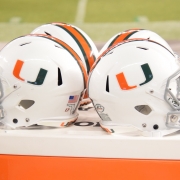
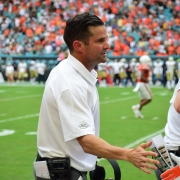
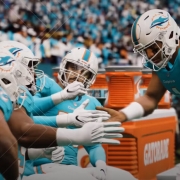
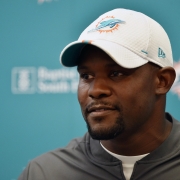
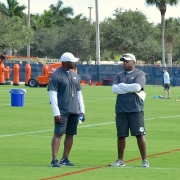

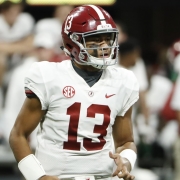 University of Alabama Athletics
University of Alabama Athletics